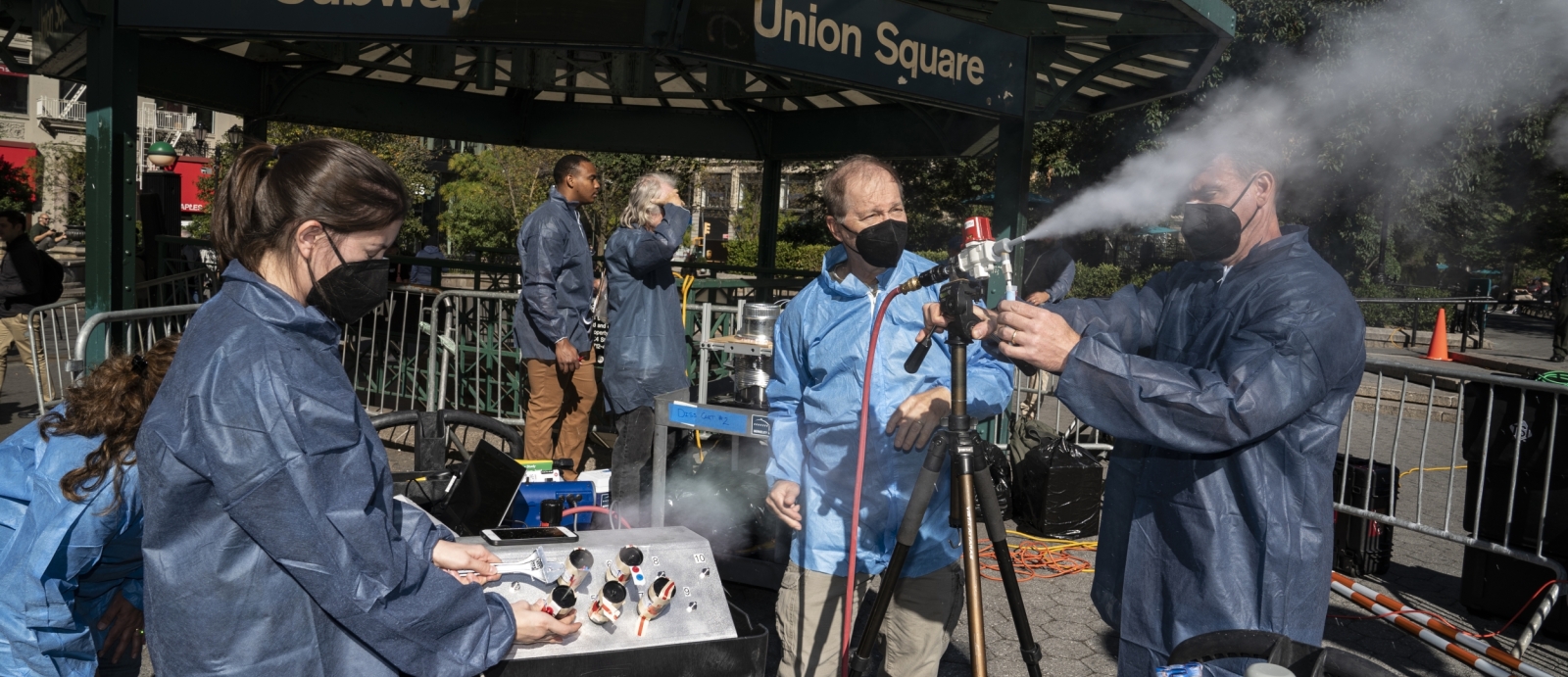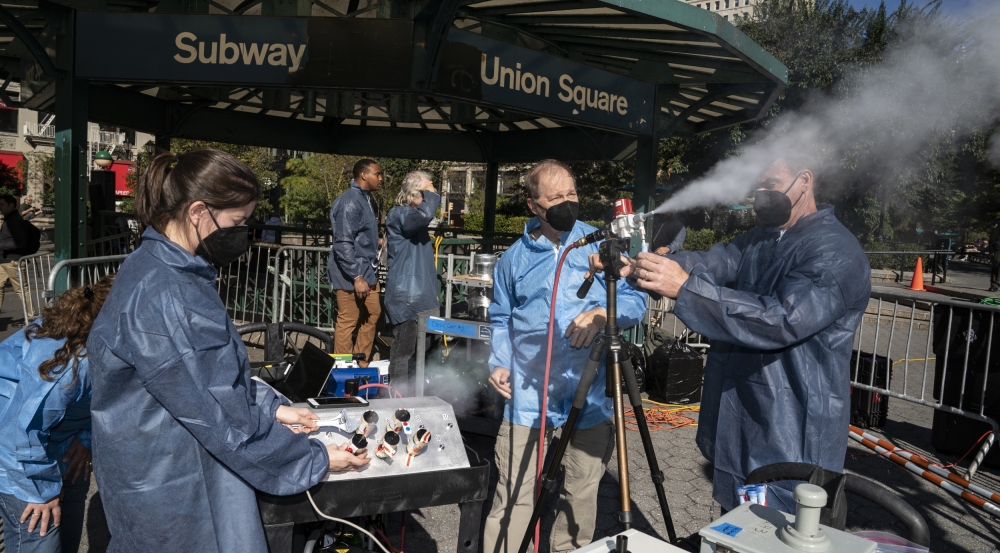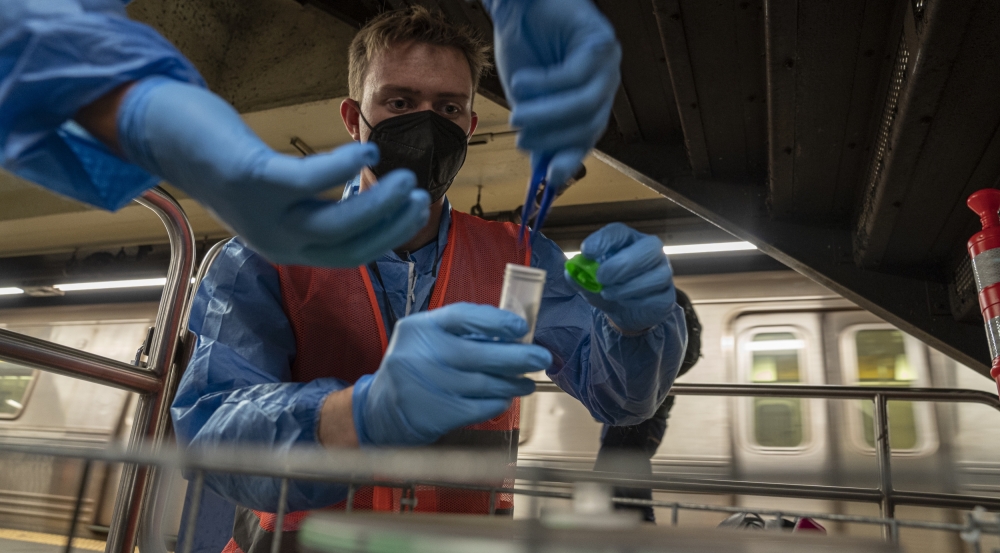
Study aims to mitigate chemical and biological airborne threats
When the air harbors harmful matter, such as a virus or toxic chemical, it's not always easy to promptly detect this danger. Whether spread maliciously or accidentally, how fast and how far could hazardous plumes travel through a city? What could emergency managers do in response?
These were questions that scientists, public health officials, and government agencies probed with an air flow study conducted from October 18 to 22 in New York City. At 120 locations across all five boroughs of the city, a team led by Lincoln Laboratory collected safe test particles and gases released earlier in subway stations and on streets, tracking their journeys. The exercise measured how far the materials traveled and what their concentrations were when detected.
The results are expected to improve air dispersion models, and in turn, help emergency planners improve response protocols if a real chemical or biological event were to take place.
The study was performed under the Department of Homeland Security (DHS) Science and Technology Directorate's (S&T) Urban Threat Dispersion Project. The project is largely driven by the Laboratory's Counter–Weapons of Mass Destruction (CWMD) Systems Group to improve homeland defenses against airborne threats. This exercise followed a similar, though much smaller, study in 2016 that focused mainly on the subway system within Manhattan.
"The idea was to look at how particles and gases move through urban environments, starting with a focus on subways," says Mandeep Virdi, a Laboratory researcher who helped lead both studies.

The particles and gases used in the study are safe to disperse. The particulates are primarily composed of maltodextrin sugar, and have been used in prior public safety exercises. To enable researchers to track the particles, the particles are modified with small amounts of synthetic DNA that acts as a unique "barcode." This barcode corresponds to the location from which the particle was released and the day of release. When these particles are later collected and analyzed, researchers can know exactly where they came from.
The Laboratory team led the process of releasing the particles and collecting the particle samples for analysis. A small sprayer is used to aerosolize the particles into the air. As the particles flow throughout the city, some get trapped in filters set up at the many dispersed collection sites.
To make processes more efficient for this large study, the team built special filter heads that rotated through multiple filters, saving time spent revisiting a collection site. They also developed a system using NFC (near-field communication) tags to simplify the cataloging and tracking of samples and equipment through a mobile app.
The research team is still processing the approximately 5,000 samples that were collected over the five-day measurement campaign. The data will feed into existing particle dispersion models to improve simulations. One of these models, from Argonne National Laboratory, focuses on subway environments, and another model from Los Alamos National Laboratory simulates above-ground city environments, taking into account buildings and urban canyon air flows.

Together, these models can show how a plume would travel from the subway to the streets, for example. These insights will enable emergency managers in New York City to develop more informed response strategies, as they did following the 2016 subway study.
"The big question has always been, if there is a release and law enforcement can detect it in time, what do you actually do? Do you shut down the subway system? What can you do to mitigate those effects? Knowing that is the end goal," Virdi says.
A new program, called the Chemical and Biological Defense Testbed, has just kicked off to further investigate those questions. Laboratory researcher Trina Vian is leading this program, also under S&T funding.
"Now that we've learned more about how material transports through the subway system, this testbed is looking at ways that we can mitigate that transport in a low-regret way," Vian says.
According to Vian, emergency managers don't have many options other than to evacuate the area when a biological or chemical sensor is triggered. Yet current sensors tend to have high false-alarm rates, particularly in dirty environments. "You really can't afford to make that evacuation call in error. Not only do you undermine people's trust in the system, but also people can become injured, and it may actually be a non-threatening situation."
The goal of this testbed is to develop architectures and technologies that could allow for a range of appropriate response activities. For example, the team will be looking at ways through which air flow could be constrained or filtered in place, without disrupting traffic, while responders validate an alarm. They'll also be testing the performance of new chemical and biological sensor technologies.
Both Vian and Virdi stress the importance of collaboration for carrying out these large-scale studies, and in tackling the problem of airborne dangers in general. The testbed program is already benefitting by using equipment provided through the CWMD Alliance, a partnership of DHS and the Joint Program Executive Office for Chemical, Biological, Radiological and Nuclear Defense.
A team of nearly 175 personnel worked together on the air flow exercise, spanning the Metropolitan Transportation Authority, New York City Transit, New York City Police Department, Port Authority of New York and New Jersey, New Jersey Transit, New York City Department of Environmental Protection, the New York City Department of Health and Mental Hygiene, the National Guard Weapons of Mass Destruction Civil Support Teams, the Environmental Protection Agency, and Department of Energy National Laboratories, in addition to S&T and Lincoln Laboratory.
"It really was all about teamwork," Virdi reflects. "Programs like this are why I came to Lincoln Laboratory. Seeing how the science is applied in a way that has real actionable results and how appreciative agencies are of what we're doing has been rewarding. It's exciting to see your program through, especially one as intense as this."